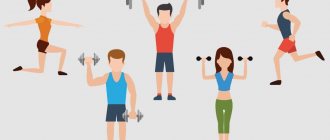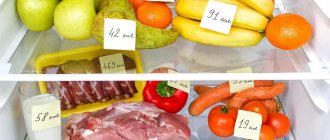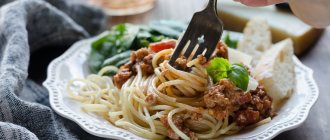Every person dreams of having a beautiful, strong and healthy, toned body. However, simply going on a diet or occasionally doing exercises is not enough for this. Without properly planned physical activity and a structured diet, it is unlikely that you will be able to lose excess weight. To understand exactly how to calculate calorie consumption during physical activity, plan your personal regimen and calculate PP for losing weight or maintaining normal weight, consider the tables we have compiled in this article.
The process of fat burning during training
When an ordinary person has the idea that his weight has somehow gone beyond the desired values and needs to be somehow brought back to normal, then the decision to do fitness, run, swim, etc. seems quite logical.
In general, it is worth increasing physical activity, which will increase energy expenditure and help reduce excess weight and “burn” subcutaneous fat. The decision has a well-founded logic, because gaining and losing weight is nothing more than the simple mathematics of the balance of incoming and outgoing calories. However, no matter how paradoxical it may sound, training in this aspect is very much overrated. Losing those hated pounds without following a diet is virtually impossible. Mathematics is not an abstract science, but an exact one. Our fat burning program, including. Therefore, if you use specific numbers rather than figurative quantities, the overall picture begins to look somewhat different. I bring this “mathematics” in numbers to your attention.
Swimming
One of the most beneficial types of physical activity. Swimming helps keep all the muscles of the body toned. Has a beneficial effect on the spine and joints. This is one of the few types of activities that has the smallest list of contraindications.
In addition, this is a great way to lose weight and stay fit. The main load falls on the upper body: shoulders, biceps, triceps. Calorie consumption is 12 kcal/hour per kg of athlete’s weight.
Calories in
So, in order to lose excess weight, it is necessary to ensure a negative balance between calories in and calories out. Therefore, the first step is to understand how many calories are in the “arrival”.
All food that enters our body consists of basic nutrients - Proteins, Fats and Carbohydrates, abbreviated as BJU. Each nutrient has its own energy value, namely, how much energy a given nutrient can provide to our body if used as fuel. Energy is measured in joules (J); in nutrition, it is usually measured in calories (cal). The correspondence between the second and the first looks like 1 cal = 4.184 J. [1] If the body uses proteins or carbohydrates as fuel, then this gives 4 kilocalories (kcal) per 1 gram of substance used, if fats - then 9 kcal.
For example, if we ate 2 eggs and a sandwich with butter and cheese for breakfast, then the energy value of our meal will be [2]:
- Eggs B = 12.7 g % F = 11.5 g % Y = 0.7 g % kcal = 157 (100 g serving)
- Russian cheese B = 23 g % F = 29 g % U = 0 g % kcal = 72 (serving 20 g)
- Wheat bread B = 8.7 g % F = 1.5 g % Y = 39 g % kcal = 21 (10 g serving)
- Butter 82.5% B = 0.5 g % F = 82.5 g % Y = 0.8 g % kCal = 75 (10 g portion)
- In total, the total calorie content of breakfast will be 325 kcal
According to the example given, the entire daily calorie content is calculated and this is the amount of energy that we have in the so-called “arrival”. To lose weight, you need to spend more energy (kcal) than you consume or eat less than you expend. No less important is alcohol. One gram of alcohol is 7 kcal. For example, 100 ml of vodka contains 40% alcohol, which gives 40 * 7 = 280 kcal. 100 ml of beer contains from 4 to 7% alcohol, sugar 3 - 4%, therefore, if you drink a “bottle” (0.5 l) of beer, you can get about 230 kcal (based on U = 3.5 g%, alcohol 4.5 g% 3.5 *4*5 + 4.5*7*5)
Does cooking help you lose weight?
Cook while standing, use kitchen appliances to a minimum, and then an hour at the stove will destroy 90-100 calories. It is important not to taste anything during the process, otherwise you risk consuming more calories than you burn.
Helpful advice: To increase energy expenditure, increase the intensity of your movements and the speed of doing housework. To make it easier to keep up the pace, turn on your favorite music. This way you can cope with routine responsibilities faster, get a boost of energy and good mood.
How many calories are burned?
Let's start with the fact that every living organism has a Basic (basal) Metabolism (BM). Basal metabolism is the proportion of daily energy expenditure for the activity of internal organs and tissues, for constant physiological functions (breathing, blood circulation, muscle tone, etc.) [1] Basal Metabolism is measured on an empty stomach in a supine position at an air temperature of 18 - 20 C. On average in an adult, the OO value is 1 kcal per kg of weight per hour. For example, if you weigh 80 kg, then your daily OO will be 1 kcal x 80 kg x 24 hours = 1920 kcal. The OO figure will be slightly different for boys (14-17 years old), whose OO is significantly higher - 1.7 kcal, for girls, their OO is 1.2 kcal, for people over 40, their OO, on the contrary, becomes less by 4-5% , and at an older age it decreases even more significantly - by 10%. [1]
Basic Metabolism is, as it were, the starting point for calculating energy expenditure, to which additional calories are added as household/work or sports activity increases. The energy consumption figures are quite clear; they are measured using the calorimetry method, so it is quite easy to calculate the final energy consumption figure. In particular, according to the “Physiology of Nutrition” [1], “background” household energy consumption - for housework, walking to the store or work, personal hygiene, etc., is generally considered to be 2 kcal. The cost of mental activity, say, office work, is like 1.5 kcal. Energy expenditure on physical work, of course, is already large and, for example, the work of a bricklayer or miner is 6 kcal.
Now, knowing the figures for energy expenditure during various types of life activities, we can calculate the above example of an 80-kilogram person more accurately. Let's assume that he gets 8 hours of sleep, he works as a manager in an office (8-hour work day) and there is no training today. (in fact, training energy expenditure will be given separately, since this is what the emphasis is on in this article).
So, the daily energy expenditure of a person weighing 80 kg on a working day (8 hours) by a manager will be:
- Sleep: 8 hours x 1 kcal/hour x 80 kg = 640 kcal
- Work: 8 hours x 1.5 kcal x 80 kg = 960 kcal
- Background activity of the day: 8 hours x 2 kcal x 80 kg = 1280 kcal
- TOTAL: 2880 kcal
Burning calories during physical activity: tables by type of physical activity
While at least some people who want to lose weight are aware of sports activities, not many people know how many calories are spent during daily physical activity. Let's look at this issue in more detail, because even just sitting on the couch while watching TV can also burn energy. True, the amount of calories expended in this case turns out to be so tiny that it is more than covered by even a minimal food intake, so it is unlikely that you will be able to lose weight while sitting in a chair.
Calorie cost table for activity at home
Housework
| Activity/calorie consumption per hour | Per 1 kg of weight | For 50 kg weight | For 60 kg weight | For 70 kg weight | For 80 kg weight |
| Cleaning | 3 | 171 | 206 | 240 | 274 |
| Sweeping | 2 | 121 | 145 | 169 | 193 |
| Dusting | 1 | 58 | 70 | 82 | 93 |
| Washing dishes | 3 | 171 | 206 | 240 | 274 |
| Cooking food | 1 | 57 | 69 | 80 | 91 |
| Clean carpets and floors with a vacuum cleaner | 3 | 146 | 176 | 205 | 234 |
| Window cleaning | 4 | 200 | 240 | 280 | 320 |
| Ironing (standing) | 2 | 104 | 124 | 145 | 166 |
| Plumbing care | 4 | 196 | 236 | 275 | 314 |
Care for children
| Activity/calorie consumption per hour | Per 1 kg of weight | For 50 kg weight | For 60 kg weight | For 70 kg weight | For 80 kg weight |
| Games while sitting | 2 | 101 | 121 | 141 | 161 |
| Walking with a stroller | 2 | 108 | 129 | 151 | 173 |
| Bathing | 3 | 134 | 161 | 188 | 215 |
| Feeding, dressing | 2 | 101 | 121 | 141 | 161 |
| Carrying on hands | 3 | 134 | 161 | 188 | 215 |
| Moderately active games | 4 | 201 | 241 | 281 | 321 |
| High activity games | 5 | 268 | 321 | 375 | 429 |
Taking care of hygiene, nutrition and rest
| Activity/calorie consumption per hour | Per 1 kg of weight | For 50 kg weight | For 60 kg weight | For 70 kg weight | For 80 kg weight |
| Lying on the sofa | 1 | 55 | 66 | 77 | 88 |
| Dream | 1 | 32 | 39 | 45 | 51 |
| Sitting in a chair | 1 | 72 | 86 | 100 | 114 |
| Eating while standing | 1 | 66 | 80 | 93 | 106 |
| Conversation over meals | 1 | 66 | 80 | 93 | 106 |
| Sex | 1 | 54 | 64 | 75 | 86 |
| Sex (active) | 2 | 107 | 129 | 150 | 171 |
| Shower | 1 | 66 | 80 | 93 | 106 |
| Dressing and undressing | 2 | 86 | 103 | 120 | 137 |
Physical activity outside the home
Work and study
| Activity/calorie consumption per hour | Per 1 kg of weight | For 50 kg weight | For 60 kg weight | For 70 kg weight | For 80 kg weight |
| Lesson or classroom activity | 1 | 57 | 69 | 80 | 91 |
| Office work | 1 | 62 | 75 | 87 | 99 |
| Computer set | 2 | 100 | 120 | 140 | 160 |
| Working at the computer | 1 | 72 | 87 | 101 | 115 |
| Bookbinder's work | 2 | 121 | 146 | 170 | 194 |
| Shoemaker's work | 3 | 129 | 154 | 180 | 206 |
| Cutting and sewing | 2 | 79 | 94 | 110 | 126 |
| Reading aloud | 2 | 79 | 94 | 110 | 126 |
| Knitting or crocheting (sitting) | 2 | 86 | 103 | 120 | 137 |
| Hairdressing services | 2 | 101 | 121 | 141 | 161 |
| Massage therapist's work | 4 | 210 | 252 | 294 | 336 |
| Carpenter's work | 3 | 171 | 206 | 240 | 274 |
| Wood chopping | 4 | 214 | 257 | 300 | 343 |
| Brick laying | 6 | 286 | 343 | 400 | 457 |
| Working with a hand saw | 7 | 343 | 411 | 480 | 549 |
| Playing the piano | 2 | 108 | 129 | 151 | 173 |
| Playing the guitar (standing) | 3 | 144 | 173 | 202 | 231 |
| Singing | 2 | 86 | 103 | 120 | 137 |
Active lifestyle and entertainment
| Activity/calorie consumption per hour | Per 1 kg of weight | For 50 kg weight | For 60 kg weight | For 70 kg weight | For 80 kg weight |
| Fishing | 2 | 86 | 103 | 120 | 137 |
| Shopping | 3 | 150 | 180 | 210 | 240 |
| Walking the dog | 3 | 143 | 171 | 200 | 229 |
| Driving | 2 | 107 | 129 | 150 | 171 |
| Driving a motorcycle (scooter) | 3 | 160 | 192 | 224 | 256 |
| Bowling | 4 | 180 | 216 | 252 | 288 |
| Ballroom dancing | 4 | 196 | 236 | 275 | 314 |
| Slow dancing | 3 | 143 | 171 | 200 | 229 |
| Hiking | 3 | 168 | 201 | 235 | 269 |
| Walking uphill | 5 | 270 | 324 | 378 | 432 |
| Diving | 5 | 257 | 309 | 360 | 411 |
| Modern dance | 5 | 229 | 274 | 320 | 366 |
| Dance Sport | 6 | 346 | 416 | 485 | 554 |
| Mountaineering | 7 | 324 | 388 | 453 | 518 |
| Ballet | 11 | 536 | 643 | 750 | 857 |
Race walking and running
| Activity/calorie consumption per hour | Per 1 kg of weight | For 50 kg weight | For 60 kg weight | For 70 kg weight | For 80 kg weight |
| Race walking | 6 | 297 | 357 | 416 | 475 |
| Easy running | 7 | 346 | 416 | 485 | 554 |
| Running up the stairs (down) | 8 | 386 | 463 | 540 | 617 |
| Running with obstacles | 9 | 429 | 514 | 600 | 686 |
| Running up the stairs | 13 | 643 | 771 | 900 | 1029 |
| Intense running | 11 | 536 | 643 | 750 | 857 |
Exercises in the gym
| Activity/calorie consumption per hour | Per 1 kg of weight | For 50 kg weight | For 60 kg weight | For 70 kg weight | For 80 kg weight |
| Stretching | 2 | 90 | 108 | 126 | 144 |
| Light gymnastics | 3 | 171 | 206 | 240 | 274 |
| Static yoga | 3 | 160 | 192 | 224 | 268 |
| Charger | 4 | 214 | 257 | 300 | 343 |
| Aerobics | 5 | 260 | 312 | 364 | 416 |
| Ashtanga yoga | 6 | 300 | 360 | 420 | 480 |
| Vigorous gymnastics | 7 | 325 | 390 | 455 | 520 |
| Elliptical trainer | 7 | 370 | 444 | 518 | 592 |
| Power training | 7 | 371 | 446 | 520 | 594 |
| Jumping rope | 8 | 386 | 463 | 540 | 617 |
Game sports, skating
| Activity/calorie consumption per hour | Per 1 kg of weight | For 50 kg weight | For 60 kg weight | For 70 kg weight | For 80 kg weight |
| Table tennis | 3 | 146 | 176 | 205 | 234 |
| Slow cycling | 3 | 132 | 159 | 185 | 211 |
| Rowing | 3 | 150 | 180 | 210 | 240 |
| Volleyball | 4 | 182 | 219 | 255 | 291 |
| Hockey | 4 | 220 | 264 | 308 | 352 |
| Figure skating | 4 | 179 | 214 | 250 | 286 |
| Roller skating | 4 | 221 | 266 | 310 | 354 |
| Badminton | 4 | 182 | 219 | 255 | 291 |
| Basketball | 5 | 271 | 326 | 380 | 434 |
| Skiing | 5 | 260 | 312 | 364 | 409 |
| Cycling at medium speed | 5 | 229 | 274 | 320 | 366 |
| Football | 6 | 321 | 386 | 450 | 514 |
| Tennis | 6 | 290 | 348 | 406 | 464 |
| Horseback riding | 6 | 280 | 336 | 392 | 448 |
| Skiing | 7 | 346 | 416 | 485 | 554 |
| Field hockey | 7 | 350 | 420 | 490 | 560 |
| Handball | 7 | 346 | 416 | 485 | 554 |
| Intense cycling | 8 | 386 | 463 | 540 | 617 |
| Ice-skating race | 11 | 550 | 660 | 770 | 880 |
| Struggle | 16 | 800 | 960 | 1120 | 1280 |
How energy expenditure is measured
Methods for determining energy expenditure are called calorimetry. There are two such methods - Direct and Indirect calorimetry.
- Direct, the method is labor-intensive and is rarely used, only in laboratory conditions. It is almost impossible to apply it to a person, especially during various types of physical activity. The very meaning of the method is that, assuming that all types of energy in the body are ultimately converted into heat, then by determining the amount of heat released by the body, you can calculate the number of calories expended. With this measurement, the subject is placed in an isolated volume, such as a pressure chamber, in which the change in temperature of the subject can be recorded. Doing this, say, with laboratory mice is quite possible, but with a person who performs some type of physical activity, you understand, it is quite problematic. Therefore, in relation to people, the second method is used.
- Indirect calorimetry is based on the measurement of the main oxidation products of organic substances, which include carbon dioxide (CO2) and nitrogen (NH3). For this, a portable breathing device is used - a gas analyzer, which measures the amount of inhaled O2 and exhaled CO2. This method is not as cumbersome as the first one, and it can be used for various types of activities, say, the load on an exercise bike and measuring an athlete’s energy expenditure in this case is quite simple.
To measure energy consumption using this method, tables and the so-called are used. Respiratory Coefficient (RK).
Respiratory Coefficient is the ratio of CO2 released by the body to oxygen consumed O2. This coefficient for carbohydrates is equal to 1, for fats – 0.707, for proteins 0.801. [1]
Having measured the amount of inhaled O2 and exhaled CO2, the first step in calculating energy expenditure is to take into account the energy expenditure of protein. To do this, the nitrogen excreted in the urine is analyzed. With normal sweating, the amount of urine nitrogen will correspond to the amount of oxidized proteins - 1 g of urine nitrogen = 6.25 g of protein. [1] Thus, the total amount of nitrogen will make it possible to calculate the total amount of protein consumed.
The second step of the calculation is to determine “protein-free” energy expenditure. To do this, the corresponding values of gases used for protein metabolism are subtracted from the total volumes of CO2 and O2. It has been established that the oxidation of 1 g of protein consumes 966.3 ml of O2 and produces 773.9 ml of CO2 [1]. By multiplying these values by the amount of oxidized protein and subtracting these values from the total volume of measured gases, the remainder is protein-free values of carbon dioxide and oxygen.
Next, the Respiratory Coefficient is included in the calculation. The CO2/O2 ratio will show in what proportion the energy consumption of carbohydrates and fats occurred. The resulting amount of fats and carbohydrates is multiplied by the caloric value of the corresponding substance (9 kcal for fats and 4 for carbohydrates) and the already calculated caloric content of oxidized proteins is added at the rate of 1 g x 4 kcal. As a result, the total energy consumption is obtained using the Indirect Calorimetry Method.
Sources[edit | edit code]
- Maclean PS, Bergouignan A, Cornier MA, Jackman MR: Biology's response to dieting: the impetus for weight regain. Am J Physiol Regul Integr Comp Physiol 2011, 301:R581-R600.https://www.ncbi.nlm.nih.gov/pubmed/21677272?dopt=Abstract&holding=f1000,f1000m,isrctn
- Ravussin E, Burnand B, Schutz Y, Jequier E: Energy expenditure before and during energy restriction in obese patients. Am J Clin Nutr 1985, 41:753-759. https://www.ncbi.nlm.nih.gov/pubmed/3984927?dopt=Abstract&holding=f1000,f1000m,isrctn
- Leibel RL, Rosenbaum M, Hirsch J: Changes in energy expenditure resulting from altered body weight. N Engl J Med 1995, 332:621-628. https://www.ncbi.nlm.nih.gov/pubmed/7632212?dopt=Abstract&holding=f1000,f1000m,isrctn
- Doucet E, St-Pierre S, Almeras N, Despres JP, Bouchard C, Tremblay A: Evidence for the existence of adaptive thermogenesis during weight loss. Br J Nutr 2001, 85:715-723. https://www.ncbi.nlm.nih.gov/pubmed/11430776?dopt=Abstract&holding=f1000,f1000m,isrctn
- Rosenbaum M, Hirsch J, Gallagher DA, Leibel RL: Long-term persistence of adaptive thermogenesis in subjects who have maintained a reduced body weight. Am J Clin Nutr 2008, 88:906-912. https://www.ncbi.nlm.nih.gov/pubmed/18842775?dopt=Abstract&holding=f1000,f1000m,isrctn
- Rosenbaum M, Leibel RL: Adaptive thermogenesis in humans. Int J Obes 2010, 34(Suppl 1):S47-S55. OpenURL
- Weigle DS: Contribution of decreased body mass to diminished thermic effect of exercise in reduced-obese men. Int J Obes 1988, 12:567-578. https://www.ncbi.nlm.nih.gov/pubmed/3235273?dopt=Abstract&holding=f1000,f1000m,isrctn
- Weigle DS, Brunzell JD: Assessment of energy expenditure in ambulatory reduced-obese subjects by the techniques of weight stabilization and exogenous weight replacement. Int J Obes 1990, 14(Suppl 1):69-77. discussion 77–81
- Doucet E, Imbeault P, St-Pierre S, Almeras N, Mauriege P, Despres JP, Bouchard C, Tremblay A: Greater than predicted decrease in energy expenditure during exercise after body weight loss in obese men. Clin Sci 2003, 105:89-95. https://www.ncbi.nlm.nih.gov/pubmed/12617720?dopt=Abstract&holding=f1000,f1000m,isrctn
- Rosenbaum M, Vandenborne K, Goldsmith R, Simoneau JA, Heymsfield S, Joanisse DR, Hirsch J, Murphy E, Matthews D, Segal KR, Leibel RL: Effects of experimental weight perturbation on skeletal muscle efficiency in human subjects. Am J Physiol Regul Integr Comp Physiol 2003, 285:R183-192. https://www.ncbi.nlm.nih.gov/pubmed/12609816?dopt=Abstract&holding=f1000,f1000m,isrctn
- Maclean PS, Bergouignan A, Cornier MA, Jackman MR: Biology's response to dieting: the impetus for weight regain. Am J Physiol Regul Integr Comp Physiol 2011, 301:R581-R600. https://www.ncbi.nlm.nih.gov/pubmed/21677272?dopt=Abstract&holding=f1000,f1000m,isrctn
- Tappy L: Thermic effect of food and sympathetic nervous system activity in humans. Reprod Nutr Dev 1996, 36:391-397. https://www.ncbi.nlm.nih.gov/pubmed/8878356?dopt=Abstract&holding=f1000,f1000m,isrctn
- Ravussin E, Lillioja S, Anderson TE, Christin L, Bogardus C: Determinants of 24-hour energy expenditure in man. Methods and results using a respiratory chamber. J Clin Invest 1986, 78:1568-1578. https://www.ncbi.nlm.nih.gov/pubmed/3782471?dopt=Abstract&holding=f1000,f1000m,isrctn
- Miles CW, Wong NP, Rumpler WV, Conway J: Effect of circadian variation in energy expenditure, within-subject variation and weight reduction on thermic effect of food. Eur J Clin Nutr 1993, 47:274-284. https://www.ncbi.nlm.nih.gov/pubmed/8491165?dopt=Abstract&holding=f1000,f1000m,isrctn
- Levine JA: Non-exercise activity thermogenesis (NEAT). Best Pract Res Clin Endocrinol Metab 2002, 16:679-702. https://www.ncbi.nlm.nih.gov/pubmed/12468415?dopt=Abstract&holding=f1000,f1000m,isrctn
- Weyer C, Walford RL, Harper IT, Milner M, MacCallum T, Tataranni PA, Ravussin E: Energy metabolism after 2 y of energy restriction: the biosphere 2 experiment. Am J Clin Nutr 2000, 72:946-953. https://www.ncbi.nlm.nih.gov/pubmed/11010936?dopt=Abstract&holding=f1000,f1000m,isrctn
- Rosenbaum M, Hirsch J, Gallagher DA, Leibel RL: Long-term persistence of adaptive thermogenesis in subjects who have maintained a reduced body weight. Am J Clin Nutr 2008, 88:906-912. https://www.ncbi.nlm.nih.gov/pubmed/18842775?dopt=Abstract&holding=f1000,f1000m,isrctn
- Leibel RL, Hirsch J: Diminished energy requirements in reduced-obese patients. Metabolism 1984, 33:164-170. https://www.ncbi.nlm.nih.gov/pubmed/6694559?dopt=Abstract&holding=f1000,f1000m,isrctn
- Jastroch M, Divakaruni AS, Mookerjee S, Treberg JR, Brand MD: Mitochondrial proton and electron leaks. Essays Biochem 2010, 47:53-67. https://www.ncbi.nlm.nih.gov/pubmed/20533900?dopt=Abstract&holding=f1000,f1000m,isrctn
- Rolfe DF, Brand MD: Contribution of mitochondrial proton leak to skeletal muscle respiration and to standard metabolic rate. Am J Physiol 1996, 271:C1380-1389. https://www.ncbi.nlm.nih.gov/pubmed/8897845?dopt=Abstract&holding=f1000,f1000m,isrctn
- Rolfe DF, Brown GC: Cellular energy utilization and molecular origin of standard metabolic rate in mammals. Physiol Rev 1997, 77:731-758 https://www.ncbi.nlm.nih.gov/pubmed/9234964?dopt=Abstract&holding=f1000,f1000m,isrctn
- Rolfe DF, Newman JM, Buckingham JA, Clark MG, Brand MD: Contribution of mitochondrial proton leak to respiration rate in working skeletal muscle and liver and to SMR. Am J Physiol 1999, 276:C692-699. https://www.ncbi.nlm.nih.gov/pubmed/10069997?dopt=Abstract&holding=f1000,f1000m,isrctn
- https://www.sciencedaily.com/releases/2014/12/141208144408.htm
How many calories are burned during exercise?
How many calories are burned during training? It was indicated above that a miner’s energy expenditure, amounting to 6 kcal/hour/kg, can be taken as comparable values to strength training. We take them as a starting point, however, the final figure of energy expenditure for a workout must be adjusted, and not simply multiplied by 6 kcal by the time spent in the gym. 6 kcal will not be spent the entire training time, but only when the person is “under load”, i.e. lifts the barbell. The rest time between approaches, when we sit, lie or at best walk, is unreasonable to calculate according to the “miner’s caloric value”, as you understand. The rest time in terms of calories is comparable to normal background energy expenditure, which is expected to be 2-3 kcal/hour/kg.
Considering the above, energy expenditure for a 2-hour workout in the proportion of 1 min approach/3 min rest, for an 80 kg athlete will have the following values:
(80 kg * 2 hours * ¼ * 6 kcal) + (80 kg * 2 hours * ¾ * 2 kcal) = 240 kcal + 240 kcal = 480 kcal
Thus, if a 2-hour strength training is carried out, then this requires 480 kcal. And, to be more precise, only 240, since we would have spent half of the “training” energy expenditure in any case. These are “background” energy expenditures that the body spends during normal household activities, for example, if we stayed at home and, say, cooked dinner.
However, the reader can say that there are also “training” 240 kcal left and neglecting them would be incorrect mathematics. If we add up the training 240 from the first, second and subsequent workouts, they will ultimately lead us to the desired result!
I am not against training; moreover, being an athlete and a coach, I cannot be against training. However, mathematics is an exact science! 240 kcal – how much is in fat? Dividing 240 by the energy value of fat (9 kcal), we get 27 g. That is, if we take into account that we spent all the energy in fat, which is not the case, then we will burn 27 g of fat during the workout. How much do you want to lose, 2 kg? No, 10 kg? Then calculate how many workouts you need to do to lose 2 kg. Do you know how much? 74! How many times a week do you plan to exercise, 3 (THREE)? Then you need 24 weeks or 6 months to lose 2 kg of fat only by training without changing your diet! ...if 10 kg, then 2.5 years!
Intimate activities
Sex can improve your mood, relieve physical stress, rejuvenate the body , and, of course, burn calories. It cannot be compared with running or walking in terms of the number of calories lost, but still, productive exercise in this type of physical and very pleasant activity will bring its owner a loss of 5 kcal/hour.
This time includes not only the most intense exercises, but also pre-preparation for the process, so experts recommend not to deny yourself a pleasant way to lose excess weight. For comparison, diving, rowing and bowling burn about the same amount of calories.
What reduces the effectiveness of training fat burning?
- Psychology. When starting to train, a weight loss enthusiast gives himself the indulgence to eat a little more and a little tastier. The rationale here is: “I work out, burn calories, so I can afford to eat this bun.” The calorie content of an ordinary bun is approximately 260 kcal; if it is rich, then it is approximately 330 kcal! We compare it with the energy expenditure of training, and we get that by eating an “extra” bun, you can completely forget about the process of losing weight!
- As a rule, the fair half of humanity is concerned with fat burning and very often only aerobic exercises are chosen for this purpose. Let's say you do cardio on a treadmill 3 times a week. Energy costs in this case will be even less significant. If we assume that the weight of our representative of the weight loss is 60 kg, she does cardio for an hour, then, excuse me, it is absolutely unreasonable to calculate her energy expenditure according to the caloric intake of a miner! She will be able to develop energy expenditure to a level of, well, 3, maximum 4 kcal. If you calculate what you get in practice, it will be: 60 kg * 1 hour * 4 kcal = 240 kcal
Walking
Walking is one of the types of gentle physical activity. It is used to warm up muscle mass before exercise or used as the main load. Here, a lot depends on the physical capabilities of the person, his physique and medical indications. In addition, walking is also divided into subtypes:
- traditional;
- sports;
- with loads, etc.
Calorie consumption depends on the initial weight of the athlete and the type of walking that he chose for exercise. One hour of traditional walking for a person weighing 50 kg will be 350 kcal; if the weight is 60-70 kg, then calorie consumption will increase to 500 kcal/hour.










